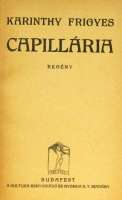Capillaria
Capillaria (Hungarian: Capillária, 1921) is a fantasy novel by Hungarian author Frigyes Karinthy, which depicts an undersea world inhabited exclusively by women, recounts, in a satirical vein reminiscent of the style of Jonathan Swift, the first time that men and women experience sex with one another.
| Author | Frigyes Karinthy |
|---|---|
| Original title | Capillária. |
| Translator | Paul Tabori |
| Cover artist | Lilla Lóránt |
| Country | Hungary |
| Language | Hungarian |
| Genre | Fantasy |
| Publisher | Corvina Press |
Publication date | 1921 |
Published in English | 1965 |
| Media type | Print (hardcover & paperback) |
| Preceded by | Voyage to Faremido |
Expressing a pessimistic view of women, the novel suggests that, with disastrous effect, women, who are emotional and illogical, dominate men, the creative, rational force within humanity, who represent the builders of civilization.
The males, known as bullpops, are of small stature. They spend their time building and rebuilding tall, complex, rather phallic towers that the gigantic women destroy as quickly as these structures are erected. Meanwhile, the females engage in sexual adventures, surviving by eating the brains of the miniature men, who have become little more than personified male genitals.
The undersea kingdom is mentioned in the comic book version of The League of Extraordinary Gentlemen.
A readily available summary of the relatively rare novel's plot is provided in The Dictionary of Imaginary Places.[1]
Adaptations

A radio dramatisation of Capillaria titled Voyage to Capiilaria was transmitted on BBC Radio 3 on 17 February 1976. It was adapted for radio by George Mikes, and produced and directed by Martin Esslin. It featured the voices of John Rowe as Gulliver, Jane Wenham as the Queen of Capillaria, plus Norma Ronald, Garard Green, and others.[2]
Related works
Capillaria, which purports to be the sixth voyage of Swift's Lemuel Gulliver, is the sequel to Karinthy's 1916 novel, Voyage to Faremido,[3] in which he is transported from the battlefields of World War I to Faremido. There he encounters men of steel with musical voices and brains composed of a "mixture of quicksilver and minerals."
Voyage to Faremido and its sequel, Capillaria, are presented by the author as the fifth and sixth journeys of Gulliver.
Capillaria is a distinct novel, with a different topic. Science, nature, etc. are not discussed (or mentioned only slightly); the novel's main topic is the coexistence of men and women. Also the genre of the two novels are different: Voyage to Faremido is an example of utopian-satirical literature, but Capillaria is not utopian.
See also
References
- Manguel, Alberto, and Gianni Guadalupi. The Dictionary of Imaginary Places. New York, Harcourt, Brace, Jovanovich, 1980, p. 66-8
- "Voyage to Capiilaria". BBC Genome Project. BBC.
- Some publishers have released the two novels together in a combined edition. A German edition places them together under the title: The New Travels of Lemuel Gulliver (German: Die neuen Reisen des Lemuel Gulliver). The novels are distinct, however, and have little in common.
Sources
- Karinthy, Frigyes (1916). Utazás Faremidóba; Gulliver ötödik útja (in Hungarian). Budapest: Athenaeum.
- Karinthy, Frigyes (1921). Capillária (in Hungarian) (first ed.).
- Karinthy, Frigyes (1965). Voyage to Faremido. Capillaria. Introduced and translated by Paul Tabori. Budapest: Corvina Press.
- Karinthy, Frigyes (1966). Voyage to Faremido. Capillaria. Introduced and translated by Paul Tabori. New York: Living Books.
- Karinthy, Frigyes (1976). Utazás Faremidóba. Capillária (in Hungarian). Budapest: Szépirodalmi Könyvkiadó.
- Karinthy, Frigyes (1983). Die neuen Reisen des Lemuel Gulliver (in German). Translated by Hans Skirecki. Berlin: Verlag Das Neue Berlin.
- Manguel, Albert; Gianni Guadalupi (1999) [1980]. The Dictionary of Imaginary Places. New York: Harcourt, Brace, Jovanovich.
External links
- Karinthy Frigyes, Capillária. (in Hungarian) (complete text online)
- Frederiko Karinthy, Vojaĝo al Faremido, Kapilario, tradukis: Lajos Tarkony, Hungara Esperanto-Asocio, Budapest, 1980. (in Esperanto) (complete text online through Wayback engine at archive.org)
- Frigyes Karnithy timeline from the Frankfurt '99 Non-profit Organisation
- Lóránt Czigány. "The Grotesque: Frigyes Karinthy". A History of Hungarian Literature: From the Earliest Times to the mid-1970s.
- "Hungarian Authors". The Hungarian Book Foundation. Archived from the original on 2005-04-12.
- Capillaria title listing at the Internet Speculative Fiction Database